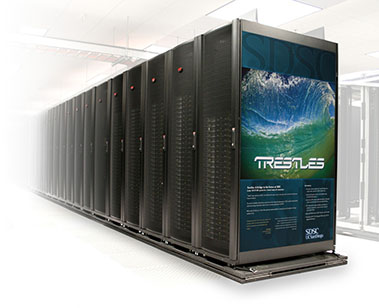University of Arkansas Acquires New Supercomputer for Research Support

Trestles was deployed at the San Diego Supercomputer Center at the University of California, San Diego, with a $2.8 million National Science Foundation grant.
FAYETTEVILLE, Ark. – A workhorse of a supercomputer is coming to the University of Arkansas.
The National Science Foundation and the San Diego Supercomputer Center at the University of California, San Diego, have agreed to transfer ownership of the computer cluster known as “Trestles” to the Arkansas High Performance Computing Center.
Once installed, the new supercomputer will more than double the center’s computational capacity and allow it to run three times the amount of jobs for campus researchers, said David Chaffin and Jeff Pummill, interim co-directors of the center.
“We are thrilled to acquire a prominent national resource for high performance computing,” Pummill said. “Researchers at the University of Arkansas are in a perpetual state of evolution and advancement in their computational needs, and Trestles is known throughout the national high-performance computing community as a ‘high-productivity workhorse.’”
The Arkansas High Performance Computing Center, founded in 2008, supports research for about 260 users in about 30 academic areas across the campus, including bioinformatics, physics, integrated nanoscience, computational chemistry, computational biomagnetics, materials science and spatial science, among others.
“Trestles will provide much-needed infrastructure for solving tasks such as genome assembly and other data-intensive problems,” Pummill said.
Trestles has 256 servers, 16.4 terabytes of memory and a processing speed of 79 teraflops. A teraflop is the measurement of 1 trillion calculations per second, with the “tera” meaning trillion and the “flop” standing for “floating-point operations” per second.
While a typical desktop computer has four processing cores, Trestles has 8,192.
By comparison, the U of A’s flagship supercomputer, dubbed Razor, has a processing speed of 77 teraflops from its 4,328 processing cores.
“High-performance computing plays a pivotal role in supporting vital research at the University of Arkansas,” said Jim Rankin, vice provost for research and economic development. “The addition of Trestles enhances our goal of becoming one of the top 50 public research universities in the United States.”
In 2010, the National Science Foundation awarded $2.8 million to the University of California, San Diego to deploy Trestles. Since it went online, the supercomputer has been recognized as the leading science gateway platform in NSF’s eXtreme Digital Network, a collaborative set of computer and storage resources across the United States that scientists can use for advanced computational and data-enabled research.
Richard Moore, deputy director of the San Diego Supercomputer Center and the principal investigator for Trestles, said, “During its four-year run at SDSC, Trestles successfully supported thousands of national researchers with modest-scale applications as well as science gateways, with shorter turnaround times than has been typical for most HPC systems. It’s terrific that this resource can be re-deployed to advance scientific research at the University of Arkansas.”
Prior to installing Trestles, the U of A will decommission its supercomputer known as the Star of Arkansas to make room for the new supercomputer. The Star of Arkansas was activated in 2007 and at one time was listed among the world’s 500 fastest supercomputers.
About the University of Arkansas: The University of Arkansas provides an internationally competitive education for undergraduate and graduate students in more than 200 academic programs. The university contributes new knowledge, economic development, basic and applied research, and creative activity while also providing service to academic and professional disciplines. The Carnegie Foundation classifies the University of Arkansas among only 2 percent of universities in America that have the highest level of research activity. U.S. News & World Report ranks the University of Arkansas among its top American public research universities. Founded in 1871, the University of Arkansas comprises 10 colleges and schools and maintains a low student-to-faculty ratio that promotes personal attention and close mentoring.
Contacts
David Chaffin, interim co-director
Arkansas High Performance Computing Center
479-575-7669, dchaffin@uark.edu
Jeff Pummill, interim co-director
Arkansas High Performance Computing Center
479-575-4590, jpummil@uark.edu
Chris Branam, research communications writer/editor
University Relations
479-575-4737, cwbranam@uark.edu
Jan Zverina, director of communications and media relations
San Diago Supercomputer Center
858-534-5111, jzverina@sdsc.edu